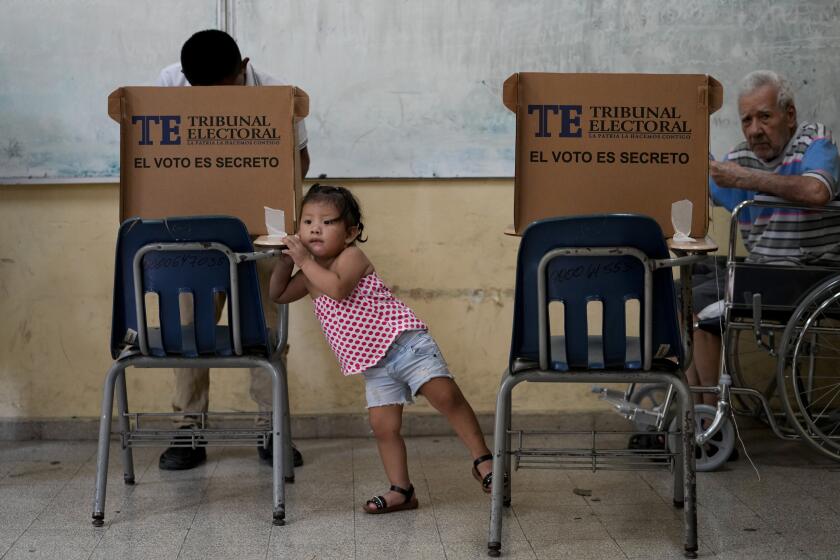Latinx Files: Is this housing policy discriminatory?

Hello and welcome to the Latinx Files. I’m Fidel Martinez, and it’s Thursday, Nov. 19. Here is what you need to know this week. (Is this your first Latinx Files newsletter? Have questions about the name? We have an explainer for that.)
“I’m like, ‘What the hell is crime-free?’ And they’re like, ‘If you have a criminal background, we can’t rent to you.’”
Finding housing in California can be difficult. It can be nearly impossible if you’ve had past run-ins with the law.
Take the case of Domingo Nuñez, who was released from jail three years ago and has since found a job that pays him enough to be able to afford a place for himself, his partner and three children. But money wasn’t an issue when it came to searching for a home in the Inland Empire communities of Hesperia, Adelanto and surrounding cities.
It was crime-free housing policies.
“When you get to these places they’re like, ‘Crime-free, crime-free, crime-free,’” Nuñez told The Times. “I’m like, ‘What the hell is crime-free?’ And they’re like, ‘If you have a criminal background, we can’t rent to you.’”
The Latinx experience chronicled
Get the Latinx Files newsletter for stories that capture the multitudes within our communities.
You may occasionally receive promotional content from the Los Angeles Times.
That’s pretty much the gist of what crime-free housing is all about — it’s a collection of policies found in thousands of cities nationwide ostensibly implemented to reduce crime by making it easier for landlords to reject new applicants or evict current tenants that have had brushes with police.
But a new investigation by my colleagues Liam Dillon, Ben Poston and Julia Barajas found that cities had inaccurately used the specter of rising crime rates as a justification for the policies, when in many cases crime was stable or falling when they were passed.
What they found instead was that when Black and Latinx people moved to the suburbs in search of safer neighborhoods and cheaper housing, crime-free housing policies often followed after them.
What’s particularly troubling is the less than thinly veiled language used by politicians to justify passing crime-free housing laws.
One Hesperia councilman said in 2015 that they were hoping “to correct a demographical problem with people that are committing crimes in this community.”
Another one, Bill Holland, likened the city ordinance to how “you would call an exterminator to kill roaches.”
The crime-free housing law passed in 2015. In December 2019, the U.S. Department of Justice sued Hesperia, alleging that the city had discriminated against Black and Latinx residents through wrongful evictions.
That case is still pending, but even if Hesperia repeals their crime-free housing ordinance, it may not matter. Neighboring Adelanto rescinded a similar law in January, but the San Bernardino County Sheriff’s Department is still conducting voluntary crime-free housing training for landlords.
Hesperia also contracts its policing to the San Bernardino County Sheriff’s Department.
OK, so why should you care if you don’t live there?
Because crime-free housing programs have been adopted by nearly 2,000 cities in 48 states, according to the International Crime Free Assn., a nonprofit started in 1992 by a Mesa, Ariz., police officer that offers crime-free housing training to local police and landlords. A version of their manual is used by the San Bernardino County Sheriff’s Department and many other police departments across California.
And similar dog-whistle language used by the Hesperia politicians can be found in that document. The most glaring example compares a would-be criminal to a “two-legged urban predator.”
The outsize influence of the International Crime Free Assn. has been found in cities in Minnesota where there’s been a rise in the Somali population. It’s been found in places like Kansas City, Mo., and the Illinois municipalities of DeKalb and Granite City — the latter was sued over claims of discrimination.
Domingo Nuñez eventually found a place to live — a duplex in Adelanto. The place has mold and bedbugs, and the septic tank overflows periodically.
“There has to be something else,” Nuñez told my colleagues.
“My kids deserve more. These little ones with special needs. They deserve a better place, and I can’t give them a better place.”
Consider subscribing to the Los Angeles Times
Your support helps us deliver the news that matters most. Become a subscriber.
Hurricane Iota is devastating Central America
Hurricane Iota struck Nicaragua on Monday, just two weeks after the country was hit by Hurricane Eta. Iota’s landfall marks the fifth year in a row in which a Category 5 storm formed, and it’s only the second time in recorded history that such a powerful storm occurred in November. It’s also the strongest hurricane to ever hit Nicaragua.
This is still a developing story, but as of this writing, the Nicaraguan government has reported that at least 16 people have died, and more than 50,000 people have been displaced. These figures are expected to rise because of potential mudslides.
Iota has since moved to El Salvador, and though it has weakened, it still poses a major threat.
If you want to keep up to date on the latest developments, we recommend following the Guardian’s reporting, or if you read Spanish, Nicaragua’s La Prensa has been doing a fantastic job — you can find them on Twitter here. Other good sources from Nicaragua include Confidencial Nicaragua and la Costeñisima.
For updates from Honduras, follow La Tribuna and El Heraldo. For El Salvador, there’s La Prensa Grafica and Diaro El Salvador.
Beyond the fact that people are dying and that some of us have family ties to Central America, you should care because the devastation left behind will likely result in mass migration to the United States. Climate change is an immigration and humanitarian issue. That is the reality in which we live.
Latin Grammys 2020: First-Time Nominees to Watch Out For
With the Latin Grammys happening tonight, I’ve asked my friend and colleague Suzy Exposito, a music reporter for The Times, to recommend some artists we should be listening to. In the words of the great Johnny Canales, take it away!
Duki & Pablo Chill-E. With his 2020 trap-metal opus “Hablamos Mañana,” Puerto Rican superstar Bad Bunny ushered in two Latin trap emcees from the Southern Cone: Argentine Duki and Chilean Pablo Chill-E. The song is now up for best urban fusion performance; Duki’s solo cut “Goteo” is also up for best rap/hip-hop song.
Anuel AA. Love him or hate him, the mouthy Puerto Rican jailbird-turned-rapper Anuel AA is making a stunning Latin Grammys debut with seven nominations, including record of the year for “China,” his all-star jaunt with Daddy Yankee, Karol G, J Balvin and Ozuna.
Lido Pimienta. “Miss Colombia,” the new album by 2017 Polaris Music Prize winner Lido Pimienta, is up for best alternative music album. Feel the Earth move with the undulating, Afro-Colombian rhythm in “Eso Que Tu Haces.”
Myke Towers. Though he may not beat out Latin Grammy heavyweight champs like J Balvin or Bad Bunny, Myke Towers might be el movimiento’s rookie of the year. His 2020 album, “Easy Money Baby,” is a goldmine of cross-cultural moments like “Girl,” a reggaeton homage to 50 Cent’s “21 Questions.”
Nathy Peluso. Heep on da heep on da what now? The Argentine singer went viral on Twitter after ColorXStudios unveiled the artist’s riotous performance of her song “Sana Sana,” a questionably sincere work of gangsta rap en español. Her new debut LP, “Calambre,” is otherwise rich with R&B eleganza.
Remembering Juan Gómez Quiñones, Q.E.P.D.
We got the sad news from a reader that Juan Gómez Quiñones, a legend in the field of Chicano studies, died last week at the age of 80. Known affectionately as GQ by those he taught, Gómez Quiñones was a mentor to the leaders of the 1968 East L.A. walkouts and helped write El Plan de Santa Barbara.
He was also the academic advisor for my colleague Gustavo Arellano when he was in grad school. Earlier this week, Gustavo eulogized Gómez Quiñones in a column. You can read it here.
Meet our readers: Matthew Luis Rivera
As I wrote in the first edition of this newsletter, the Latinx Files belongs to you. We want to hear from you, to learn your story and about your experience as a Latinx person living in this country.
To kick things off, we’ll let Matthew Luis Rivera, a 31-year-old musician in Los Angeles who grew up in Chicago’s Humboldt Park, a historic Puerto Rican enclave, talk about how he came to embrace his Afro Latino identity. Matthew and I spoke on the phone, and his comments have been lightly edited for clarity.
“I moved out to L.A., and I had these flashbacks to when I first moved to Indiana because Chicago is, from my perception, very Puerto Rican-adjacent and Puerto Rican-conscious. You can assume that if you’re walking down the street, people from all different cultures that are from Chicago will look at someone that looks like me and say ‘he’s probably Puerto Rican’ instead of saying ‘That’s a Black guy.’
“When I moved to Indiana for college, the existence of Puerto Ricans was just not there, I was really kind of just confused. I was called n— at a Wal-Mart multiple times. I was hanging out with my friends that were Black, and I was like, ‘The joke’s on them. I’m not Black. So you guys are mistaken.’ But then I [realized that] I don’t even know how I’m being looked at in the world.
“When I moved to L.A. as an adult, I was finding out that no one was assuming that I was Spanish. I would go to the east side where there are a lot of Mexicans, and they just thought I was a gringo. But when I lived in Brooklyn, if I’d go to a bodega, they’re going to start speaking Spanish to me thinking I’m Dominican or Puerto Rican right away. So I was really coming to grips with my identity and lack of identity.
“I feel like I have to code switch or affirm my identity based on wherever I am on the map. And it’s a really confusing place to be in when you’re in a room full of African Americans but you don’t identify with African American culture. But also you’re like, ‘Man, if I’m not in the circle and I’m like in another room, I’m the token, I’m the Black representative.’
“Now I say that I am Afro Latino. I’m not African American, but I’m also Black. So I really try and make sure that I’m identifying my Blackness as a crucial part of my identity. And honestly, it sometimes comes first for me.”
Meet our Latinx colleagues: Patricia Escárcega
More than 100 Latinx journalists work at the Los Angeles Times, producing journalism in English and in Spanish. Something I want to regularly do in this newsletter is to highlight the vital work they do. And who better to start with than Patricia Escárcega, one of two critics in The Times’ food section?
The scope of Patricia’s work extends beyond criticism. She co-writes our Tasting Notes newsletter, where she’s written about everything from why critics can’t ignore the pandemic to the restaurant owner who said “no love, no tacos.” And
she has reported on the struggles undocumented food workers have faced because of COVID-19, on the absence of Salvadoran cuisine in the U.S. cookbook world and on taqueras carving a space for themselves in L.A.’s male-dominated taco scene.
That last story made history: It was the first time that the word “pendejadas” was published in the L.A. Times. Oh and did I mention she’s also the paper’s first ever Latinx food critic?
The best thing on the Latinternet
This feel-good story has an even better ending. The dog was rescued by members of the Mexican marine corps, who have since adopted it and will reportedly train it to be a search and rescue dog. They’re even taking suggestions for naming it. Might I suggest “Cambio Climático”?
The viral video began in heartbreaking fashion: A dog clings for dear life to a metal railing, flood waters submerging half its body. Then a boat appears, and two men coax the pup into jumping onboard for safety.
This scene took place Saturday in the southern Mexican state of Tabasco, which has been plagued with severe flooding caused by Hurricane Eta (yes, the very same that also wreaked havoc in Nicaragua last week).
The Latinx experience chronicled
Get the Latinx Files newsletter for stories that capture the multitudes within our communities.
You may occasionally receive promotional content from the Los Angeles Times.




